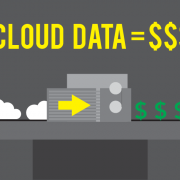Data is quickly being recognized as the lifeblood of business. For many, it’s their most valuable business asset. Customers are often more willing to give you their money than they are to give you their personal data. That alone speaks to its value. Yet like any other asset, customers won’t trust you with their stuff until you’ve demonstrated a reliable means to protect it. For business data, that means a secure data backup solution that’s easily manageable.
The Solution Lies in the Cloud
Yet just like stuffing your money into your mattress isn’t a reasonable long-term solution, neither is storing your backup data solution solely on site. We’re talking potential terabytes of data here, enough to quickly have your virtual mattress bulging. That’s why you’re seeing so many corporate data centers utilizing cloud storage. Copies are sent off-site to your cloud provider, freeing you from the task of having to worry about daily backup administration (particularly helpful if IT just isn’t your thing). Once you’ve undergone that initial installation and integration with the cloud, backup data integration concerns disappear into the virtual night. Such a service is affordable and easy to implement within your current framework.
However, pure cloud backup solutions aren’t without their occasional tempests. You have to have a large amount available bandwidth so they don’t monopolize your network connections. Some cloud providers can really throttle that bandwidth when you need to restore your data, meaning that recovery time takes that much longer. A better solution would be to have storage both in the cloud and on your main server, providing you protection on both ends.
What is a Hybrid Could Backup?
A hybrid backup strategy offered through KineticD does just that. We present you with a network-attached storage (NAS) appliance attached to your on-site area network. It’s set up with its own IP address and can provide data storage to any of the other devices on the network. The NAS synchs your backup data to the cloud. When restoration is needed, all of the data is still on-site in the NAS, or it can be recalled directly from the KineticD cloud server to the NAS appliance.
While still forcing you to maintain a greater portion of your own IT services, our KineticD hybrid backup solution still offers you a number of benefits:
- Local availability with cloud maneuverability: You get all of benefits of freed storage space, secure mobile access, and continuous data protection that come with the KineticD cloud, along with our lower costs. All of this is yours with the added peace-of-mind of knowing that your data is still safely retained behind your firewall.
- Improved scalability: You can easily allocate resources to the cloud for short-term projects. This will cost you much less than having to make changes to your own infrastructure.
- Conservative flexibility: If your management team is one that is reluctant to embrace new technology, a hybrid cloud strategy is a great way for your company to test the cloud computing model.
Let’s face it: too much of anything can be a bad thing. Just as you don’t want to tie up storage space on your server by keeping your entire backup solution on-site, you also don’t want to have to rely on your cloud provider to assist with restoration (no matter how reliable they may be). The hybrid cloud strategy offered through KineticD is the way to go, offering the best of both worlds when it comes to data retrieval. This still lets you outsource your backup administration while still having it all synched safely in your NAS.
If you have questions about how to protect your important data using the cloud, call KineticD at 1.866.430.2406 or email us at sales@kineticd.com for more information.










Leave a Reply
Want to join the discussion?Feel free to contribute!